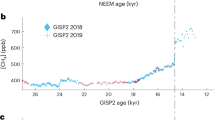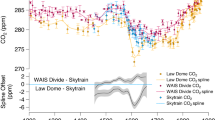Abstract
RECORDS of the variation in atmospheric methane concentration have been obtained from ice cores for the past 1,000 years and for the period 8,000–220,000 yr BP (refs 1–4), but data for the intervening period, spanning most of the present interglacial period (Holocene), are patchy (refs 5–7 and references therein). Here we present a continuous, high-resolution record of atmospheric methane from 8,000 to 1,000 yr BP, from the GRIP ice core in central Greenland. Unlike most other climate proxies from ice cores (such as oxygen isotope composition8 and electrical conductivity9), methane concentrations show significant variations—up to 15%—during the Holocene. We have proposed1 that variations in the hydrological cycle at low latitudes are the dominant control on past levels of atmospheric methane. This is now supported by the observation that the lowest methane concentrations in our new record occur in the mid-Holocene, when many tropical lakes dried up10. The concentration increases during the Late Holocene, probably owing to an increasing contribution from northern wetlands.
This is a preview of subscription content, access via your institution
Access options
Subscribe to this journal
Receive 51 print issues and online access
$199.00 per year
only $3.90 per issue
Buy this article
- Purchase on Springer Link
- Instant access to full article PDF
Prices may be subject to local taxes which are calculated during checkout
Similar content being viewed by others
References
Chappellaz, J. et al. Nature 366, 443–445 (1993).
Blunier, T. et al. Geophys. Res. Lett. 20, 2219–2222 (1993).
Jouzel, J. et al. Nature 364, 407–412 (1993).
Nakazawa, T. et al. Geophys. Res. Lett. 20, 943–946 (1993).
Chappellaz, J. et al. Nature 345, 127–131 (1990).
Stauffer, B., Lochbronner, E., Oeschger, H. & Schwander, J. Nature 332, 812–814 (1988).
Machida, T. thesis, Tohoku Univ. (1992).
Dansgaard, W. et al. Nature 364, 218–220 (1993).
Taylor, K. C. et al. Nature 366, 549–552 (1993).
Street-Perrott, F. A. Nature 366, 411–412 (1993).
Schwander, J. et al. J. geophys. Res. 98, 2831–2838 (1993).
Barnola, J. M., Pimienta, P., Raynaud, D. & Korotkevich, Y. S. Tellus 43B, 83–90 (1991).
Nisbet, E. G. J. geohys. Res. 97, 12859–12867 (1992).
Moraes, F. & Khalil, M. A. K. Chemosphere 26, 295–607 (1993).
Thompson, A. M., Chappellaz, J. A., Fung, I. Y. & Kucsera, T. L. Tellus 45B, 242–257 (1993).
Chappellaz, J. A., Fung, I. Y. & Thompson, A. M. Tellus 45B, 228–241 (1993).
Fung, I. et al. J. geophys. Res. 96, 13033–13065 (1991).
Ritchie, J. C. & Harrison, S. P. in Global Climates since the Last Glacial Maximum (eds Wright, H. E. Jr., et al.) 401–414 (Univ. Minnesota Press, Minneapolis, 1993).
Heusser, C. J., Heusser, L. E. & Peteet, D. M. Nature 315, 485–487 (1985).
Harrison, S. P., Prentice, I. C. & Guiot, J. Clim. Dyn. 8, 189–200 (1993).
Zoltai, S. C. & Vitt, D. H. Quat. Res. 33, 231–240 (1990).
Petit-Maire, N., Fontugne, M. & Rouland, C. Palaeogeogr. Palaeoclimatol. Palaeoecol. 86, 197–204 (1991).
Sukumar, R., Ramesh, R., Pant, R. K. & Rajagopalan, G. Nature 364, 703–706 (1993).
Ledru, M.-P. Quat. Res. 39, 90–98 (1993).
Petit-Maire, N. in Global Precipitation and Climate Change (eds Desbois, M. & Desalmand, F.) 3–26 (NATO ASI Ser. I, Vol. 26, Springer, Dordrecht, 1994).
Street-Perrott, F. A. & Roberts, N. in Variations in the Global Water Budget (eds Street-Perrott, A., Beran, M. & Ratliffe, R.) 331–345 (Reidel, Dordrecht, 1983).
Street-Perrott, F. A. & Perrott, R. A. Nature 343, 607–612 (1990).
Magaritz, M. Clim. Change 24, 179–185 (1993).
Van Campo, E. & Gasse, F. Quat. Res. 39, 300–313 (1993).
Latypova, E. K. & Yakheemovich, B. L. Radiocarbon 35, 441–447 (1993).
Franzên, L. G. Ambio 23, 300–308 (1994).
Rasmussen, R. A. & Khalil, M. A. K. J. geophys. Res. 89, 11599–11605 (1984).
Author information
Authors and Affiliations
Rights and permissions
About this article
Cite this article
Blunier, T., Chappellaz, J., Schwander, J. et al. Variations in atmospheric methane concentration during the Holocene epoch. Nature 374, 46–49 (1995). https://doi.org/10.1038/374046a0
Received:
Accepted:
Issue Date:
DOI: https://doi.org/10.1038/374046a0
This article is cited by
-
Panarctic lakes exerted a small positive feedback on early Holocene warming due to deglacial release of methane
Communications Earth & Environment (2023)
-
Rainfall and sea level drove the expansion of seasonally flooded habitats and associated bird populations across Amazonia
Nature Communications (2022)
-
Enhanced Arctic sea ice melting controlled by larger heat discharge of mid-Holocene rivers
Nature Communications (2022)
-
Millennial scale feedbacks determine the shape and rapidity of glacial termination
Nature Communications (2021)
-
Estimating historic movement of a climatological variable from a pair of misaligned functional data sets
Environmental and Ecological Statistics (2020)
Comments
By submitting a comment you agree to abide by our Terms and Community Guidelines. If you find something abusive or that does not comply with our terms or guidelines please flag it as inappropriate.



